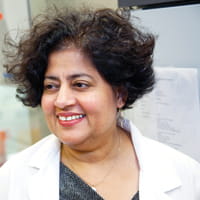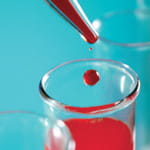Applying Nature’s Lessons
Scientists go back to basics for treatment that could yield cure for sickle cell disease
 |
Dr. Punam Malik, a researcher and hematologist at Cincinnati Children’s, thinks the cure for sickle cell disease lies in a gene we are all born with. |
More than 100,000 people in the United States have sickle cell disease. Some 1,000 children are born in this country each year with the condition, which causes episodes of crippling pain, damage to tissue and organs, and can sometimes be fatal. In Africa, nearly 1,000 children are born with the disease every day.
APPLICATIONThe vector Malik and her team developed prevents the sickle hemoglobin from forming long fibers or polymers, which is what causes them to change shape. COMING NEXTPhase I/II clinical trial will begin by end of the year in adults, then extend to children. |
There are treatments that manage symptoms with varying degrees of success, but the only cure is a bone marrow transplant from a matched sibling. This cure, unfortunately, is only available to 10 to 15 percent of all patients and carries side effects that include rejection of the transplanted bone marrow.
Punam Malik, MD, a researcher and hematologist at Cincinnati Children’s, is about to launch a clinical trial that could change that. She thinks the cure for sickle cell disease lies in a gene we are all born with.
Back To The Womb
Malik has identified a way to alter the genetic makeup of sickle cell patients by adding a modified fetal hemoglobin (HbF) gene.
For most people, HbF turns off around six months after birth and we begin producing adult hemoglobin (HbA). But children with the sickle cell mutation begin to produce a defective form of adult hemoglobin, hemoglobin S (HbS), which causes normally round red blood cells to take on the sickle shape that is characteristic of the disease.
HOW IT WORKSMalik’s team genetically engineered an HbF producing gene to fool the cell into believing it is actually an adult globin gene, so that it stays "on." They also manipulated the gene so that it preferentially forms HbF in the presence of HbS. |
In their search to end this cycle, Malik and her team took a lesson from a natural aberration.
“There are human beings in this world who live on fetal hemoglobin even as adults,” she says. “They don’t switch off their fetal hemoglobin gene, ever.”
In Africa, where sickle cell disease is common, adults with the fetal hemoglobin (HbF) gene had only mild cases of sickle cell disease. The researchers also found that when people with HbF had thalassemia — a disorder in which the body produces no red blood cells — they had no symptoms.
Borrowing from nature, Malik and her team developed a treatment that mimics production of HbF.
“We thought, nature has shown us this works — people can live into adulthood with HbF, so let’s figure out a way to put in a HbF gene that doesn’t turn off,” says Malik.
 |
She developed a vector with a HbF producing gene and modified the gene so that its “on” switch remains permanently flipped, counteracting the sickle hemoglobin and preventing sickling. She then worked with scientists in Cincinnati Children’s Vector Production Facility (see next page) to develop the clinical grade of this vector.
“We genetically engineered it to fool the cell into believing that it is actually an adult globin gene, so that it stays on. We also manipulated the gene so that it preferentially forms HbF in the presence of HbS.”
The vector Malik and her team developed prevents the sickle hemoglobin from forming long fibers or polymers, which is what causes them to change shape. In the process of testing the vector, the researchers found that it cured thalassemia as well.
“We have mice with sickle cell disease and mice with thalassemia, and we take their bone marrow, remove the stem cells, fix them and give it back to them, and they are cured of the disease,” she says.
Expanding the Trial
Malik and her team expect to start the Phase I/II clinical trial by end of year in adults. If all goes well, they will extend the trial to children.
Malik says despite the remarkable success they have had in animal trials, the next steps of applying the treatment to humans will be slow and careful.
“First we have to know: is it safe, is it effective? Is it effective in every sickle patient?,” she says. “Then we have to streamline and simplify the process, and expand it to more people. But we wouldn’t go into a trial if we didn’t think it would work.”
Mosquitoes And Sickle Cell |
|
When a malaria-carrying mosquito slides her needle-like proboscis into the arm of an unsuspecting victim, she unleashes a parasite and a reproductive free-for-all. The parasite quickly finds its way to the liver, then into the bloodstream, dividing exponentially as it goes. Left unchecked, a single parasite can destroy all of its victim’s red blood cells within two weeks. In tropical areas of the world where malaria is common, nature has provided some people protection against this assault. They carry a genetic trait that causes their red blood cells to sickle, or harden into a crescent shape, when infected by the malaria parasite. This appears to stunt the parasite’s ability to reproduce. |
The same genetic trait that affords protection from malaria, however, can cause sickle cell disease. People who receive the mutated gene from both parents are at highest risk of developing the lifelong, cripplingly painful and sometimes fatal sickle cell disease. Sickle cell disease causes red blood cells to have a distinctive crescent-like, or sickle, shape. The cells are unable to carry oxygen throughout the body; they clump together, blocking blood flow, damaging organs and causing severe pain. |



